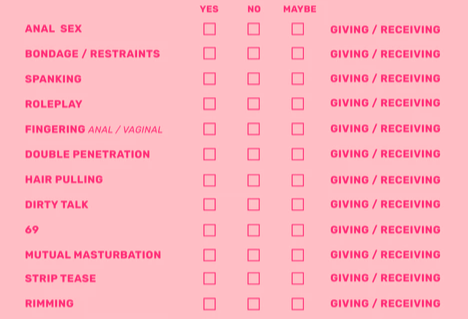A yes, no, maybe list is a document that catalogs its creator’s interest in trying different sexual activities. Typically, this document lists acts they want to try in the "yes" column, acts they feel uncomfortable trying in the "no" column and acts they could consider in the "maybe" column. You may see this document written as a yes/no/maybe list or called a yes, no, maybe checklist.
A yes, no, maybe list can include any sex practices a person can think of. It usually focuses on acts of pleasure, but may also include more practical boundary-setting, such as whether it's OK to make eye contact, what a partner likes to be called during sex and much more. Some of the activities someone may include on their yes, no, maybe list include:
- Different sex positions
- BDSM practices, such as bondage, spanking and using blindfolds
- Role-playing scenarios
- Increasing eye contact during sex
- Sex with the lights on or off
- Sex in different locations
- Using sexual health items, like lubricant
- Using different sex toys, such as vibrators or anal beads
- Exploring fetishes, such as latex or food play
- Sharing sexual fantasies
- Reading erotica
- Sharing sexual history
- Taking an STI test
- Using different types of birth control

Why Make a Yes, No, Maybe List
Making a yes, no, maybe list can be a useful tool to spark discussions about sex and sexual health and help people learn more about their partners. It may also open people up to new sexual possibilities. It can help people in new relationships assess their sexual compatibility and navigate their sex lives together. People in long-term relationships might use a yes, no, maybe list to improve their connection and understanding of one another and expand their sexual horizons. This can reignite a spark for people who feel sex has become predictable or routine.
How to Make and Use a Yes, No, Maybe List
People can make a yes, no, maybe list with their partners by following these steps:
1. Create or find a template
People can use an established yes, no, maybe list template or create their list from scratch. When creating this document from scratch, divide the page into four vertical columns titled sex acts, yes, no and maybe. Then list the sex acts to categorize in the left column. Alternatively, simply list the sex acts and leave space for writing yes, no or maybe beside them. Try to be as specific as possible to avoid confusion. For example, “hand stuff” could mean fingering, hand jobs, mutual masturbation or digital penetration. Listing giving and receiving sex acts separately also makes this document clearer. Make enough copies of the yes, no maybe for everyone in the relationship to complete.
2. Categorize the sex acts
Classify each sex act as a yes, no, or maybe by marking the appropriate column or writing these words or their initials, depending on the template. Some people prefer using a numerical grading system to show their level of interest. It’s a good idea for each partner to complete this step without the other partner(s) present. This ensures each person doesn't feel influenced by their partners’ opinions.
3. Compare lists
Partners can then come back together to compare their lists and see which acts they share similar views on. Highlighting shared "yes" acts can be a good visual aid for further exploration. People might also cross out any acts that received a no from one or more partners.
4. Discuss sex acts
A non-judgmental discussion can help people understand their partner’s perspectives and preferences. Good topics for discussion include the reasons for giving activities certain classifications, circumstances where someone might consider "maybe" acts, and feelings about sex acts people have categorized differently. Listening to a partner and respecting their limits is important. Discussing the yes, no, maybe lists at least once a year can prompt partners to share any changes in their preferences or interests.
More About Yes, No, Maybe List
A yes, no, maybe list can be a useful document for couples who want to clarify and explore their sexual interests. People might use this document if they’re vanilla, kinky or a member of the BDSM community. Remember that it doesn't matter what the acts listed are or how kinky they are. What matters is finding areas of common ground and a point of exploration for partners.
Yes, No, Maybe Lists and BDSM
Yes, no, maybe lists originated in the BDSM community to help dominants and submissives understand their desires and ensure they aligned before scenes. While there may be some overlap between activities on vanilla and BDSM lists, lists for BDSM often include more intense activities that focus on power play. For example, they may feature serious impact play and kinkier fetish activities. These discussions may even be used to build a BDSM contract.
Yes, No, Maybe Lists and Consent
Categorizing items on a yes, no, maybe list isn’t the same as giving consent for them. While someone may be more likely to consent to the acts in the "yes" column of their list, their partner should discuss and gain consent before trying something on this document.
“Consent is always crucial, even after establishing a yes, no, maybe list, because desires and boundaries can change over time,” adds Mary Smith, a licensed relationship and dating specialist, wedding planner and the founder of Vowness.com. “What someone may have been open to in the past could become a firm ‘yes’ or ‘no,’ and vice versa. That’s why ongoing communication and consent are vital to ensure both partners feel comfortable and enthusiastic about any sexual activity. The yes, no, maybe list is not a binding contract, but a tool to facilitate discussions around consent. It should be viewed as a dynamic document that prompts couples to revisit and update it regularly.”
People can also withdraw consent at any time, so it’s important to gain consent every time, even if a partner has consented to an act on the list previously.
Templates and Apps for Yes, No, Maybe Lists
These yes, no, maybe list templates make creating these documents easy. Check them out and find one that works for you!
- One Condoms' Yes, no, maybe list
- Scarleteen’s Yes, No, Maybe: A Sexual Inventory Stocklist
- Leah Carey’s Yes/No/Maybe List (for beginners)
- Sunny Megatron’s Yes/No/Maybe List
- Bex Caputo’s Super Powered Yes/No/Maybe List
- William Lynch’s Yes – No – Maybe Checklist
- Diana Sadat’s Yes/No/Maybe So Activity List
- Professor Sex’s Trauma Informed Yes No Maybe List
- Yes-No-Maybe: A Kinky List
- Poly Notes’ Poly Yes/No/Maybe List
The following apps also help people create yes, no, maybe lists:
- Vectron soft’s Yes/No/Maybe List for Couples (Android)
- Yes/No/Maybe List App (Free and pro versions for Android)
- Spicer (Android and iOS)
Incorporating Acts From a Yes, No, Maybe List Into Your Sex Life
With a clear understanding of a partner’s desires and preferences, people can start experimenting with acts for pleasure on the list. After confirming consent, start with "yes" acts in common with a partner as these will likely be the most mutually pleasurable. Afterward, partners can discuss their feelings about the act and whether they might try it again or change anything about the experience. Over time, people might move out of their comfort zone and try some "maybe" acts. Acts for pleasure with "no" classifications should remain off limits - even if one partner is interested in them - to show respect for boundaries.



